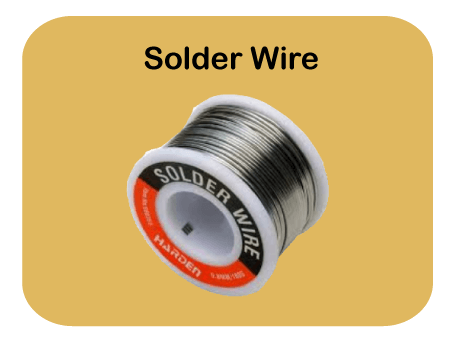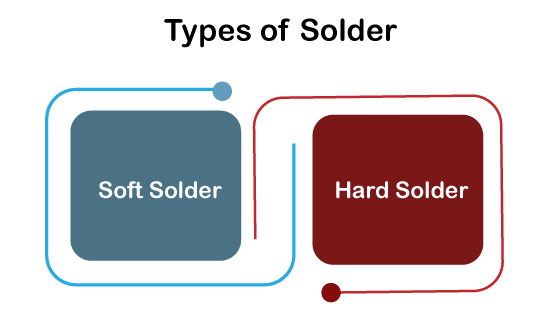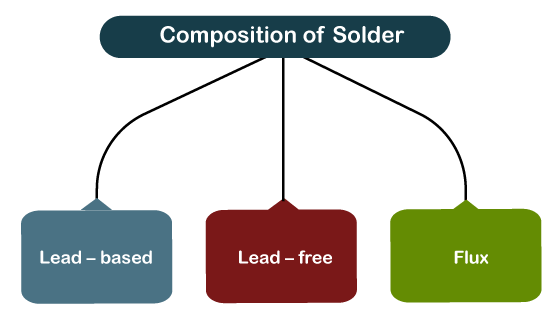SolderThe solder is a term used in the soldering process. It acts as a filler material between the two workpieces (generally metals) to be joined. The solder creates a strong bond between the two workpieces. Soldering is an inexpensive method as compared to welding and brazing. All three terms are used to fuse the two workpieces. Solder in the form of wire is shown below: 
Here, we will discuss the soldering kit, process to remove the solder, types of solder, composition, and blends of the solder materials. Soldering kitLet's discuss the soldering kit. The soldering kit comprises of a solder (material that acts as filler), soldering iron, soldering station (needed for variable temperature control), solder stand (required to place the hot soldering iron when not in use), wet sponge (for cleaning the soldering iron tip), solder wick (used to remove the solder from the components), rosin flux (used to clean the metal surface) and the required material (workpieces) on which the soldering is to be done. Hence, we can say that solder wick is a type of copper wire coated with rosin flux, which is used to remove the solder from the components or workpieces. Let's discuss the process to remove the solder. Today, most of the modern solder comes with built-in rosin flux. It does not require any external rosin flux for its cleaning. It automatically breaks down the oxides on the surface of the metal. Process to remove the solderTe removing of solder from the component is also known as desoldering. The circuit board components are difficult to remove or change when the solder is present on them. The desoldering process helps us to remove the component from the circuit boards easily. The process to remove the solder is listed below:
Thus, the above process can be used to remove the solder from the desired component. In case we are unable to remove the solder, we can reapply the solder on that component and follow the same process discussed above. Types of Solder
The solder is categorized as hard solder and soft solder, depending on the temperature requirements. The common soldering process requires a temperature of 190 degrees Celsius. But, for large projects, high-temperature soldering can also be used. The melting point of solder is required to be less than the melting point of the workpieces. The higher temperature solder can weaken the bond between the two workpieces to be joined. Soft SolderThe temperature of the soft solder is less than 450 degrees Celsius. The specified temperature range upto 450 degrees is the standard requirement for the soldering process. A temperature higher than 450 is termed as hard solder. Hard SolderThe temperature requirement of the hard solder is more than 450 degrees Celsius. Hard solder is commonly preferred for brazing. It is used in jewellery making. It requires red heat to melt. Here, red heat signifies the metal heated till it turns red or strong heating. Composition of SolderThe solder is made of metal that melts when heated with the soldering iron. It cools after it is applied to the components. 
The composition refers to the materials that it is made up of. It can be categorized as:
Let's discuss this in detail. Lead-basedThe lead-based solders contain lead and tin as the composition of solder. The percentage contribution of tin is between 5% and 70% by weight. The higher percentage of tin provides added strength to the solder. In the United States, the use of lead is prohibited due to its toxic nature. Note: The lead can harm the human through the soil, air, water, paint, and dust. It damages the kidney and the immune system of human beings.In the applications of soldering in plumbing, the use of lead was replaced by other metals. The advantages of lead-based solder include low temperatures and better quality. But, its toxic nature has made it a poisonous substance for the health of human beings. Hence, lead-free solders replaced lead-based solders. Lead- freeThe lead-free solder is the solders with no composition of lead in it. The tin percentage is increased, and the lead was replaced by other metals, such as solver or antimony. Lead-free solder composition comprises other metals, such as copper, tin, bismuth, antimony, zinc, etc. The combination of tin, silver, and copper is used for hand soldering and wave soldering applications. In order to add compatibility to the solder, the addition of the fourth element has been recently discovered. The fourth element can be Zinc or Manganese. FluxFlux is used to break down the formation of the oxide at the surface of the metals. It adds mechanical strength at the points of contact. The flux can be categorized as active flux and passive flux. Active flux includes the strong acids that are used for the applications, such as plumbing. Passive flux contains rosin that is generally used in electronics. Due to some environmental concerns, the use of rosin flux has been replaced by water-soluble flux. The water-soluble flux is easy to remove with detergents or purified water (de-ionized water). It is because the removal of flux after soldering is essential. Solder BlendsThere are various types of solder available with different composition of metals. Let's discuss the role of additive components: AlloysAlloys are a combination of one or more than one metal. Let's discuss the role of various metals and their effect as additives to the solder material. 
Copper Copper improves the wetting (potential of a liquid to maintain contact with the solid surface) property of the melted solder. It also forms intermetallic compounds. Zinc Zinc is an inexpensive material with a low melting point. But, its corrosive nature is not suitable for some of the applications. It requires flux to prevent oxidation and corrosion. The most commonly used solder alloys with zinc composition are Zinc-cadmium, Zinc- tin-lead, etc. Tin As discussed, tin is the main composition of solder alloys. The higher percentage of tin adds strength to the solder. It also lowers the melting point of the solder. Some of the parts (that need to be joined) cannot resist higher temperatures. Hence, low-temperature solder is used to join such parts. Antimony Antimony helps in increasing the strength of the solder. It does disturb the wettability of the solder. Indium Indium improves the ductility (the ability of a material to be easily stretched into wires) of the solder. Silver Silver adds mechanical strength to the solder. The combination of copper and zinc as the alloy material of solder is used for brazing. The addition of silver also provides corrosion resistance joints. The addition of certain materials with silver, such as cadmium or lead, can be toxic.
Next TopicTypes of Thermometer
|
 For Videos Join Our Youtube Channel: Join Now
For Videos Join Our Youtube Channel: Join Now
Feedback
- Send your Feedback to [email protected]
Help Others, Please Share









